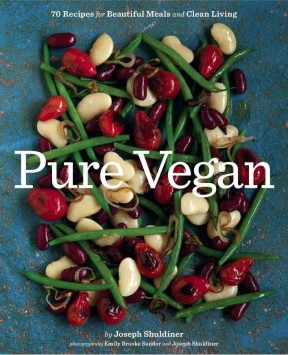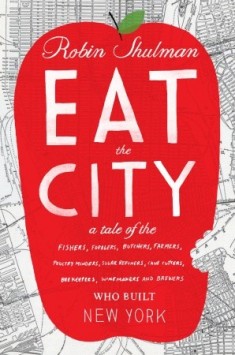A Girl and Her GreensHearty Meals from the Garden
From the chef, restaurant owner, and author of the critically lauded A Girl and Her Pig comes a beautiful, full-color cookbook that offers tantalizing seasonal recipes for a wide variety of vegetables, from summer standbys such as zucchini to earthy novelties like sunchokes.
A Girl and Her Greens reflects the lighter side of the renowned chef whose name is nearly synonymous with nose-to-tail eating. In recipes such as Pot-Roasted Romanesco Broccoli, Onions with Sage Pesto, and Carrots with Spices, Yogurt, and Orange Blossom Water, April Bloomfield demonstrates the basic principle of her method: that unforgettable food comes out of simple, honest ingredients, an attention to detail, and a love for the sensual pleasures of cooking and eating.
Written in her appealing, down-to-earth style, A Girl and Her Greens features beautiful color photography, lively illustrations, and insightful sidebars and tips on her techniques, as well as charming narratives that reveal her sources of inspiration.
April Bloomfield is the executive chef and co-owner of the Michelin- starred The Spotted Pig, The Breslin, The John Dory, Tosca, and Salvation Taco restaurants. She won the 2014 James Beard Award for Best Chef in New York and was nominated for an Emmy for cohosting the second season of the PBS show Mind of a Chef. A native of Birmingham, England, she lives in New York City.
“April, April, April what a chef! Delicious, brilliant, inspiring… With her book, A Girl and Her Pig, you can now sample her splendid food in your own kitchen.” — Fergus Henderson on A Girl and Her Pig
“In a sneak peek at her new cookbook, A Girl and Her Greens, Bloomfield offers her crazy-good recipe for pan-roasted carrots with carrot-top pesto, shaved carrot salad, and creamy burrata.” — Saveur 100 Cooks’ Edition
“What makes Ms. Bloomfield’s simple food so satisfying-both at her restaurants like the Breslin and the Spotted Pig, and in her previous book, A Girl and Her Pig-are its pinpoint-perfect textures, flavors and seasonings.” — New York Times
“…I can’t imagine anyone being able to write about vegetables the way [Bloomfield] does without truly loving them… [M]y only frustration with Bloomfield’s book so far has been that the options are so tempting, it’s hard to know where to begin.” — Washington Post
Snap Pea Salad
Simple Lemon Dressing
Roasted Carrots with Carrot-Top Pesto and Burrata
P0t-Roasted Artichokes With White Wine And Capers
Carrot-Top Pesto![]()
Snap Pea Salad
I admit that I’m hard on sugar snap peas. I get disappointed when they suck, of course, but I also get grumpy when they’re anything less than perfect—unblemished, super sweet, and not a bit starchy. That’s the curse of keeping high standards, I suppose: you’re so rarely satisfied. When at last I do find perfect snap peas, I make this salad. I leave them raw—only the finest snap peas can be this delightful without a dunk in boiling water—and accentuate their flavor with little more than a lemony dressing and mint. If you’d like, you could add some creamy goat cheese in blobs or good old burrata alongside.
Serves 4
1 pound sugar snap peas, trimmed and strings removed (see note)
A five-finger pinch of mint leaves (preferably black mint), roughly chopped at the last minute
¼ cup Simple Lemon Dressing (see below)
Maldon or another flaky sea salt
Lemon juice
Large handful delicate, peppery arugula
So long as you find the right snap peas, you’ll have a smashing salad. But I find that putting your knife to them adds even more excitement, a little textural variation and attractiveness. Accordingly, run the tip of your knife along the spine of some of the larger pods, open them like a book to expose the peas, and gently pull to separate the two sides of the pod. Slice others diagonally in half or thirds. Keep small ones whole.
Combine the peas and mint in a large bowl. Pour in the dressing and toss gently but well. Season to taste with more salt and lemon, if you’d like. Add the arugula to the bowl and toss gently to coat the leaves in the dressing without bruising them. Arrange it all prettily on a platter and serve straightaway.
Note: If you wish to remove the maximum string from your snap peas, try this: With one hand, hold a snap pea so the concave side is facing you and the stem end is facing down. With the other, use a small, sharp knife to cut just below the very tip of the pea and pull towards you, removing the string in the process. Rotate the pea so the stem end is facing up and the concave side is facing away from you. Now cut just below the tip of the pea and pull towards you, removing the string along the spine of the pea. This goes quite quickly once you get the hang of it, and you never have to worry about a stringy bit mucking up a good bite.
Simple Lemon Dressing
This all-purpose dressing brightens whatever it touches, like Snap Pea Salad or Greek Salad. It proves that three simple ingredients can become something extra-special when they’re combined in just the right proportions.
Makes about 2/3 cup
½ cup extra-virgin olive oil
¼ cup lemon juice
¾ teaspoon Maldon or another flaky sea salt
Combine the ingredients in a container with a tight-fitting lid and shake well until the mixture looks creamy. Taste and add a little more oil, lemon, or salt, if you’d like. Set it aside until you’re ready to use it and shake again just before you do.![]()
Roasted Carrots with Carrot-Top Pesto and Burrata
If you can get your hands on burrata—a really special cheese, like delicate mozzarella with a creamy center—then you’re already most of the way toward a great dish. In the spring, I’ll serve burrata with Snap Pea Salad (page 23); in high summer, I’ll pair it with slices of ripe tomato, good olive oil, and flaky salt. When summer fades, I crave burrata with roasted carrots, a pairing that’s less common but no less worthy of your attention. The two are like good mates, each helping the other along: the sweetness of the carrots sets off the tanginess of the cheese; the cheese’s tanginess makes the carrots tastes even sweeter. Pesto made from the carrot tops adds color and salty, herbaceous wallops throughout the dish.
Serves 4 to 6 as a Side
20 small carrots (the size of pointer fingers), scrubbed well but not peeled, all but ½-inch of the tops removed and reserved
4 tablespoons extra-virgin olive oil
1 teaspoon plus a few pinches of Maldon or another flaky sea salt
½ pound room-temperature burrata, drained
About 3 tablespoons Carrot Top Pesto (page 234)
A five-finger pinch of basil leaves, torn at the last minute if large
1 tablespoon lemon juice
Position a rack in the center of the oven and preheat to 500˚F.
Pour 2 tablespoons of the oil into a heavy ovenproof pan big enough to hold the carrots in a single layer. Set the pan over high heat and bring the oil to a light smoke. Add the carrots, sprinkle on 1 teaspoon of the salt, and turn the carrots to coat them in the oil. Cook, turning over the carrots occasionally, until they’re browned in spots, 6 to 8 minutes. Pop the pan in the oven and roast, shaking the pan occasionally, until the carrots are evenly tender, 8 to 12 minutes, depending on the size of your carrots. Let the carrots cool slightly. Halve the burrata and arrange the halves on a platter. Arrange the carrots on the platter so they’re pointing this way and that. Add the pesto here and there in little dollops.
Pluck enough 2-to 3-inch delicate sprigs from the reserved carrot tops to make about 1½ lightly packed cups and toss them in a bowl with the basil. Whisk together the remaining 2 tablespoons of the oil with the lemon juice and a good pinch of salt in a small bowl until the mixture looks creamy. Use a little of the lemon dressing to lightly dress the carrot top–basil mixture, sprinkle on a little more salt, and toss well. Arrange the mixture on top of the carrots and burrata. Drizzle everything with the remaining lemon dressing and serve.
![]()
POT-ROASTED ARTICHOKES WITH WHITE WINE AND CAPERS
serves 4 to 6 as a side
One of the reasons I go giddy about springtime is artichokes, particularly the small ones with tips closed tightly, like a flower at night. Some home cooks are reluctant to fill their totes with artichokes, they’ll need to be turned—the barbed leaves plucked off and the other inedible bits trimmed away. I quite like the process. It’s meditative and satisfying once you get the hang of it. In this dish, the fleshy artichokes get browned and crispy tops and look like strange, beautiful roses. The acidity in the white wine cuts through the rich, dense veg and, along with the salty pops from the capers, highlights the artichokes’ unique herbaceousness.
INGREDIENTS:
1/4 cup extra-virgin olive oil
31/2 pounds baby artichokes (about 18)
2 medium garlic cloves, thinly sliced
1 1/2 teaspoons Maldon or other flaky sea salt
1 1/2 cups dry white wine, such as Sauvignon Blanc
1 heaping tablespoon drained capers
A five-finger pinch of mint leaves (preferably black mint), torn at the last minute
METHOD:
Heat the oil in a heavy pot (wide enough to hold the artichokes with room to spare) over medium-high heat until it just begins to smoke.
Stand the artichokes cut sides down in the oil, wait a minute, then reduce the heat to medium-low, sprinkle in the garlic and salt, and cook, without stirring, just until the garlic turns golden and smells toasty, about 3 minutes.
Pour in the wine, cover the pot, and cook, without stirring, at a vigorous simmer until you can insert a sharp knife into the thick artichoke bottoms with barely any resistance, about 25 minutes. Five minutes or so before they’re fully tender, scatter on the capers and cover again.
Uncover, raise the heat to medium-high, and bring the liquid to a boil.
Cook until all the wine has evaporated (the bubbling sound will become a sizzle), about 3 minutes. Add the mint and keep cooking the artichokes in the oil (it’s OK if a few of them tip over), until the cut sides of the artichokes are deep golden brown, 3 to 5 minutes. Lower the heat if necessary to prevent the artichokes from getting too dark.
Arrange the artichokes prettily on a plate, and scoop the capers, oil, and slightly crispy mint over top. Serve straightaway or at room temperature.![]()
Carrot-Top Pesto
If you’ve never nibbled a carrot top, you have a happy surprise waiting for you. The greens are delicious: a little less carroty than the roots, and almost briny, like heartier borage. Arriving home from the market with not only a collection of sweet, colorful roots but also a big old tuft of bushy tops is like ordering pork shoulder and finding out that the kind butcher has snuck a couple of trotters into your bag.
I treat the tops as I would a tender herb, adding little sprigs to salads as I might parsley or dill. And because each bunch of carrots can bring twice the volume in tops, I make pesto. As much as I like the particular flavor of the tops themselves, I also like how they carry the flavor of basil, which comes through quite a bit considering how few leaves you use.
Makes about 1 cup
4 cups lightly packed delicate carrot tops (stems discarded), roughly chopped
A small handful of basil leaves
½ cup walnut halves
1 ounce Parmesan cheese, finely grated
1 medium garlic clove, halved lengthwise
1 teaspoon Maldon or another flaky sea salt
½ cup extra-virgin olive oil
Combine the carrot tops and basil in a small food processor, pulse several times, then add the walnuts, Parmesan, garlic, and salt. Pulse several more times, add the oil, then process full-on,
Stopping and scraping down the sides of the processor or stirring gently if need be, until the mixture is well combined but still a bit chunky. Taste and season with more salt, if you fancy.
From A Girl and Her Greens by April Bloomfield. Copyright 2015 April Bloomfield. Excerpted by permission of Ecco, an imprint of HarperCollins Publishers.
Photo David Loftus











Leave a Reply